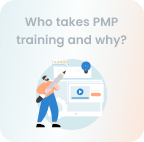







 10 Sep 2024
10 Sep 2024
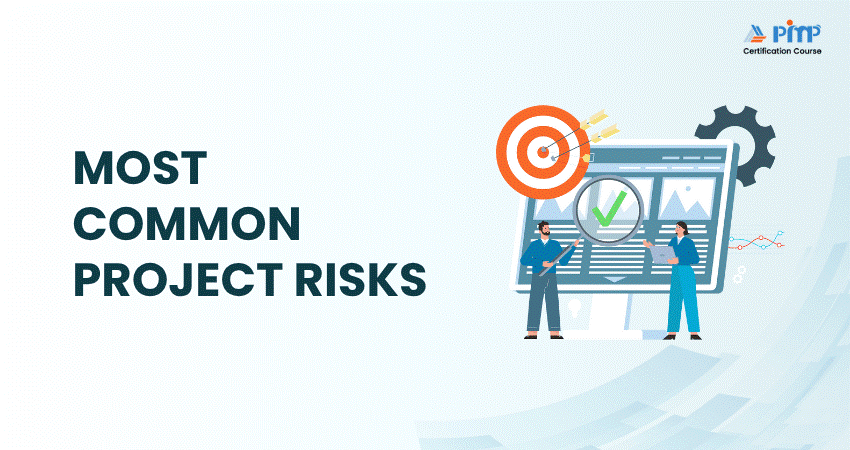


No matter how flawless your plan is, every project comes with risks. They're the “what-ifs” no one wants to think about, but every successful Project Manager must. This blog is your roadmap to navigating those uncertainties with confidence. We’ll explore the most common Project Risks and give you proactive strategies to keep them from derailing your goals. Read on!
Table of Contents
1) What is Project Risk?
2) Types of Project Risk
3) Strategies to Prevent Project Risk
4) Project Risk Management Tools
5) Conclusion
Project Risk refers to any uncertain event or condition that could impact a project’s objectives, such as its scope, timeline, cost, or quality. These risks can be positive, like opportunities or negative, such as threats. Effective risk management involves identifying, assessing, and responding to these uncertainties to reduce their impact or enhance potential benefits.
Project Risks may stem from internal factors like resource constraints or external ones like regulatory changes, supplier delays, or market shifts. Addressing risks early helps keep projects on track and ensures better decision-making throughout the project lifecycle.
Every project faces risks that can affect its success. These risks may cause delays, increase costs, or impact quality. Understanding the different types of Project Risks helps you plan better, avoid surprises, and keep your project on track.
External risks come from outside the organisation or project environment. These include natural disasters (like floods or earthquakes), geopolitical events (such as war or trade sanctions), inflation, pandemics, or changes in market conditions. Since they are largely uncontrollable, they can severely impact timelines, costs, or even project feasibility.
Example: A global chip shortage delays hardware delivery for an IT infrastructure project.
Scope creep happens when unplanned features or tasks are added after the project has started. This is without corresponding changes to time, cost, or resources. It often results from vague project requirements, a lack of change control processes, or stakeholders frequently altering expectations.
Example: A client keeps requesting new features in a Software Development project, causing deadline extensions and budget increases.
This risk refers to delays that prevent a project from being completed on time. Causes include poor time estimation, resource unavailability, task dependencies, or unexpected technical issues. Delays can lead to cost overruns and missed market opportunities.
Example: A key developer’s unplanned leave delays multiple dependent tasks, pushing the launch date.
Your path to project mastery starts with our Certified Associate in Project Management (CAPM) ® Training - Register now!
Financial risk involves any monetary uncertainty that can affect the project budget or profitability. These include cost estimation errors, inflation, exchange rate volatility, delayed payments, or funding shortfalls. If unmanaged, financial risks can halt the project mid-way or reduce its Return on Investment (ROI).
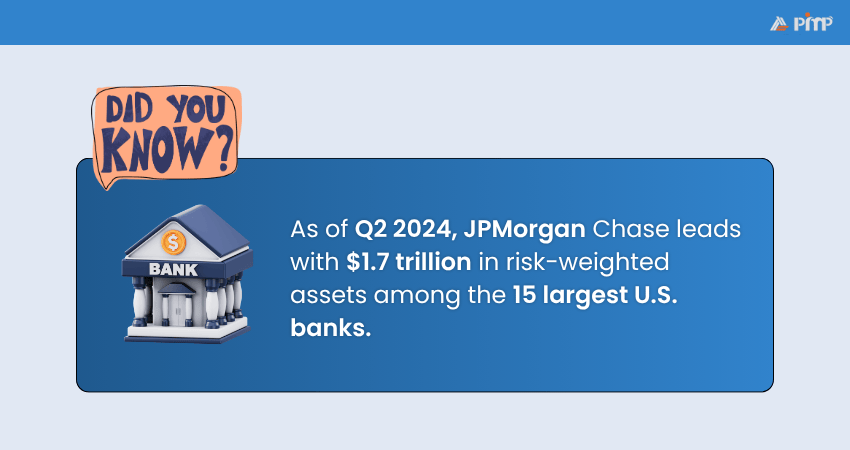
Example: Mid-project, a vendor increases prices due to inflation, exceeding the allocated procurement budget.
Strategic risks arise when a project no longer aligns with organizational objectives, market needs, or long-term value. Changes in leadership, corporate strategy, or competitor innovations may render the project irrelevant or less valuable.
Example: A company develops a new product, but a competitor launches a superior version before them, shifting market demand.
Performance risk arises when the final product or service fails to meet functional, technical, or quality expectations. It may be caused by inadequate planning, poor testing, lack of expertise, or subpar materials. This risk can damage client trust or lead to rework.
Example: A construction project uses cheaper materials to save costs but fails safety inspections, requiring costly repairs.
These involve non-compliance with legal, regulatory, or contractual obligations, which can result in fines, delays, or reputational harm. They may stem from ignorance of current laws, new regulations introduced mid-project, or non-compliance with data protection, safety, or industry standards.
Example: A healthcare app launches without meeting GDPR requirements, resulting in fines and customer backlash.
Crack the code of project success - Get Program Management Professional (PgMP)® Certification today!
Preventing Project Risks starts with being prepared. By identifying potential problems early and planning effective responses, teams can avoid costly delays and setbacks. The following strategies help manage uncertainty, reduce negative impacts, and keep your project on track from start to finish.
The first step in preventing Project Risks is to identify them before they become problems. This means scanning all aspects of the project, such as scope, schedule, budget, technology, team capabilities, and external influences. This helps uncover uncertainties that could impact project outcomes. Early identification allows you to address risks proactively, not reactively.
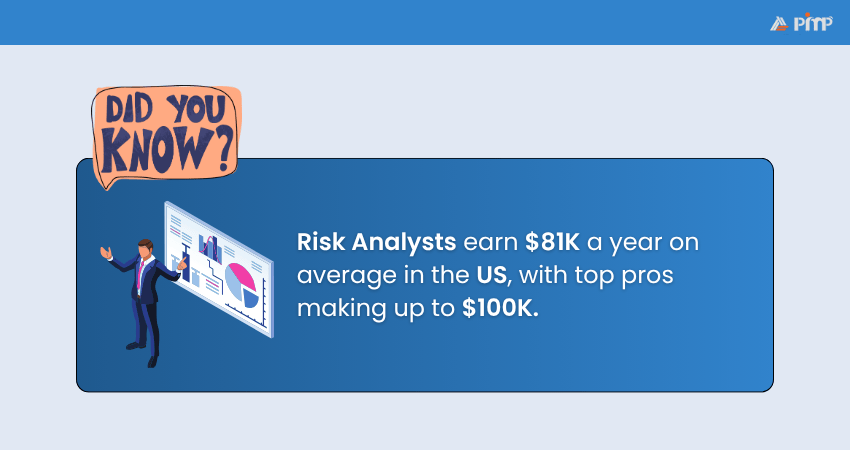
How to do it:
1) Hold risk identification workshops with team members, clients, and stakeholders.
2) Use Strengths, Weaknesses, Opportunities, Threats (SWOT) analysis to explore internal and external factors.
3) Conduct a historical review of similar projects to spot recurring risks.
4) Build a Risk Register to list identified risks, sources, and early warning signs.
Once identified, risks must be evaluated for probability and impact. This helps you prioritize which risks need urgent attention and which are manageable. Risk analysis may be qualitative (based on expert judgment) or quantitative (using data models and simulations).
How to do it:
1) Use a risk matrix to categorize risks based on severity and likelihood.
2) Assign risk scores (e.g., low, medium, high) for better decision-making.
3) Conduct Monte Carlo simulations or cost-risk modelling for financial risks.
4) Review interdependencies to see how one risk might trigger others.
Mitigation involves planning how to prevent risks from happening or reducing their impact if they do occur. A good mitigation strategy is proactive, measurable, and practical. It involves refining your plan, processes, or resources to build resilience.
How to do it:
1) Reallocate or increase resources for risk-heavy tasks.
2) Improve task clarity to reduce scope creep and misunderstandings.
3) Perform technical reviews and quality assurance checks early.
4) Engage skilled professionals or vendors when entering unfamiliar territory.
Every identified risk must have a designated owner responsible for monitoring and responding to it. This ensures accountability, clarity, and swift action if the risk escalates. A common problem in risk management is unclear ownership, which delays responses.
How to do it:
1) Assign risk owners based on their expertise and role.
2) Define clear roles and escalation procedures.
3) Use tools like a Responsible, Accountable, Consulted, Informed (RACI) chart.
4) Include risk updates as part of regular team meetings or reports.
Transparent and consistent communication is key to risk prevention. All stakeholders must be aware of risks, actions being taken, and changes to plans. Good documentation also provides a reference for future projects and audits.
How to do it:
1) Create a communication plan with risk reporting frequency and format.
2) Use tools like Trello, Jira, or MS Project to document and track risks.
3) Maintain a risk log to record actions taken, dates, and outcomes.
4) Include risk discussions in status reports and project dashboards.
Contingency plans are your backup strategies if a risk becomes reality. They are essential for minimizing disruption and keeping your project on track. These plans include resources, actions, timelines, and decision points.
How to do it:
1) Develop “Plan B” for high-impact risks with clear steps and responsibilities.
2) Set aside contingency budgets and buffer time.
3) Test your plans through risk simulations or tabletop exercises.
4) Ensure all team members know the triggers for contingency plans.
Step into leadership with globally respected Program Management Professional (PgMP)® Certification– Join now!
To manage risks effectively, project teams need the right tools to identify, assess, and respond to potential risks. Below are some of the most commonly used tools that simplify and strengthen the risk management process.
SWOT stands for Strengths, Weaknesses, Opportunities, and Threats. It's a strategic planning tool that helps Project Managers assess both internal and external risk factors.
How it Helps in Risk Management:
1) Strengths reduce risk exposure (e.g., experienced team, strong leadership).
2) Weaknesses are internal gaps that could evolve into risks (e.g., limited resources, poor communication).
3) Opportunities reveal positive external trends that may help mitigate risks or create strategic advantages (e.g., emerging technologies, market shifts).
4) Threats point out external dangers (e.g., market changes, supply chain issues).
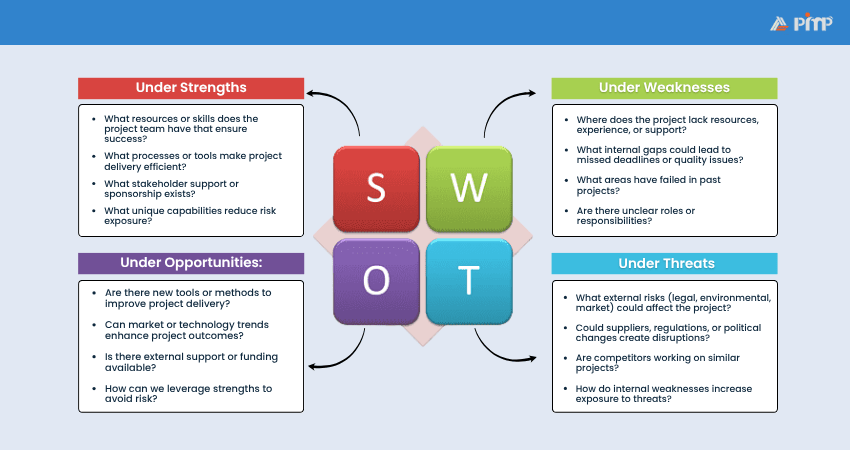
Tip: Use SWOT during the planning phase to guide risk identification and decision-making.
A Risk Register is a structured document that records all identified risks, their status, severity, mitigation plans, and assigned owners. It’s essential for tracking, managing, and updating risks throughout a project. It includes fields like risk description, probability, impact, response strategy, and action deadlines.
How it Helps in Risk Management:
1) Centralizes all identified risks in one place
2) Assigns clear risk ownership
3) Helps prioritize based on impact and likelihood
4) Tracks risk status and updates
5) Records mitigation and contingency actions
6) Supports informed decision-making
7) Enhances team communication
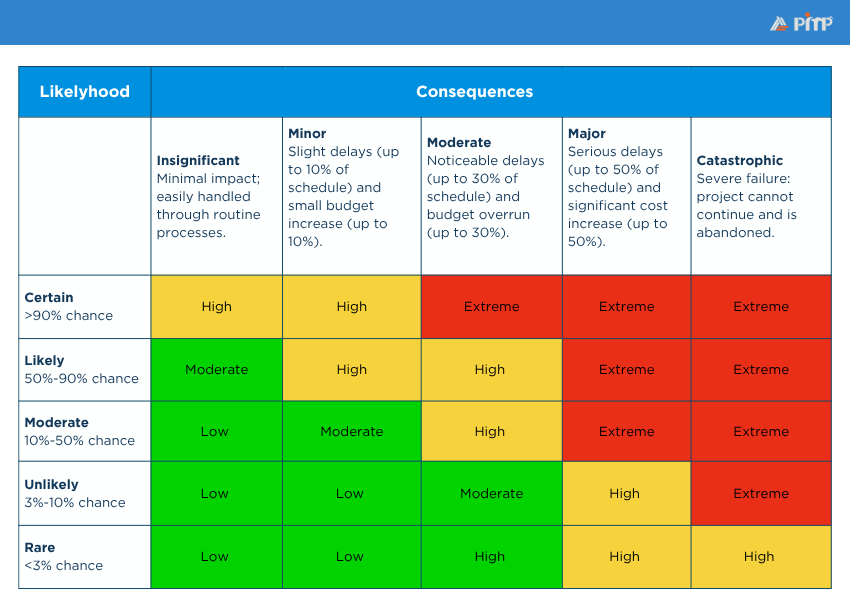
Tip: Keep your Risk Register dynamic, update it regularly to reflect new risks and status changes.
Brainstorming sessions involve team members and stakeholders generating ideas to identify and evaluate possible risks. It promotes diverse input and uncovers risks that structured tools may overlook, especially during early planning or reviews. It’s most effective in the early planning stage or during project reviews.
How it Helps in Risk Management:
1) Encourages open discussion and fresh perspectives
2) Identifies hidden or indirect risks early
3) Promotes team ownership of the risk process
4) Increases engagement and communication among stakeholders
Tip: Set clear objectives for the session, involve cross-functional teams, and document all ideas for follow-up analysis.
Understanding and managing Project Risk is key to successful project delivery. By identifying common risks, evaluating their impact, and applying proactive strategies and tools, teams can stay prepared and avoid costly setbacks. A strong risk management plan not only protects project goals but also boosts team confidence and stakeholder trust throughout the project lifecycle.
Learn from experts - Start with your Project Management Institute (PMI)® Certification today.






© Copyright 2025. All rights reserved. Contact: PMP® TRAINING ACADEMY.


